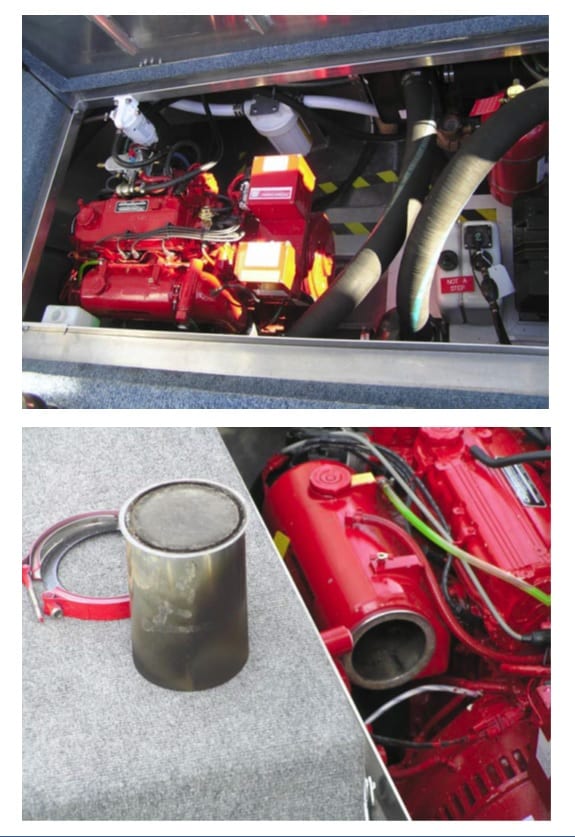Engineering Controls Database
Houseboat Carbon Monoxide Exposure - Generator Catalytic Emission Control
|
Gasoline-powered generators are commonly used on houseboats to provide electricity for air conditioning, kitchen appliances, entertainment systems, communication equipment, etc. When operating, generators produce carbon monoxide (CO). CO is a lethal poison that is produced when fuels such as gasoline or propane are burned. It is one of many chemicals found in engine exhaust resulting from incomplete combustion. Because CO is a colorless, odorless, and tasteless gas, it can overcome an exposed person without warning. The initial symptoms of CO poisoning may include headache, dizziness, drowsiness, or nausea. Symptoms may advance to vomiting, loss of consciousness, and collapse if prolonged or high exposures are encountered. If the exposure level is high, loss of consciousness may occur without other symptoms. Coma or death may occur if high exposures continue [NIOSH 1979]. During operation of on-board generators (without operation of propulsion engines), concentrations of CO in the airspace under the extended rear deck of houseboats were measured in excess of 30,000 ppm (parts per million). The National Institute for Occupational Safety and Health (NIOSH) Recommended Exposure Limit (REL) for CO is 35 ppm for full shift TWA exposure, with a ceiling limit of 200 ppm which should never be exceeded [CDC 1988]. The NIOSH REL is designed to protect workers for an 8-hour workday. NIOSH has also established an Immediately Dangerous to Life and Health (IDLH) value for CO of 1,200 ppm [NIOSH 2000]. |
|
|
Studies by NIOSH have shown that on some houseboats: • The open space under, above, or around the swim platform may contain lethal concentrations of CO if the generator exhaust discharges into this area. • During boat maintenance activities employees may be exposed to hazardous concentrations of CO. Epidemiologic investigations revealed that from 1990 through April of 2008, 309 houseboat related CO poisonings occurred in the United States. Nonfatal poisonings associated with houseboats numbered 283 with the majority of these poisonings being directly attributable to generator exhaust. Of the 309 houseboat-related CO poisonings, 26 resulted in death. More than 800 CO poisonings related to recreational boating in the United States have been identified, and that number continues to increase. [Double Angel 2008] |
|
|
NIOSH researchers evaluated if CO exposures to occupants on or near houseboats caused by gasoline-powered generators may be reduced by: • retrofitting the side-exhaust configuration to vertical stacks extending above the upper deck • adding generators equipped with catalytic emission control devices (ECD) This data base summary covers ECDs. Figure 1 is a diagram of an emission control produced by Enviromarine LLC and Figure 2 are photographs of a Westerbeke low CO generator with catalytic air control device. Recently developed ECDs were evaluated by NIOSH. These included Westerbeke Safe-COTM generators and Kohler Power Systems generators with the necessary technology to reduce CO emissions.   |
|
| 171-05VV; 171-27A; 171-29A; 171-32A; 171-36A; 171-38A; 289-14A; | |
|
CDC (1988). MMWR 37, supp (S-7) NIOSH Recommendations for Occupational Safety and Health Standards. Atlanta, GA, Dept. of Health and Human Services, Public Health Service, Centers for Disease Control and Prevention, National Institute for Occupational Safety and Health. Double Angle Foundation [2008]. Boat Related Carbon Monoxide (CO) Poisonings. Updated May 2007 – April 2008. http://www.doubleangel.org/documents/NatlCaseListingBoat- RelatedCOPoisoningsMay2007April2008_000.pdf Garcia A, McCleery R, Dowell C, Dunn KH, Earnest GS, Hall RM. An Evaluation of Catalitic emission Controls to prevent Carbon Monoxide Poisonings From Houseboat Generator Exhaust. March 2007. Callville Bay Marina, Boulder City, Nevada. U.S. DHHS, PHS, CDC, NIOSH, EPHB 171-05vv. Hall R, Earnest GS, Hammond D, Dunn KH, Garcia, A. (2014): A Summary of Research and Progress on Carbon Monoxide Exposure Control Solutions on Houseboats. June 2014. Journal of Occupational and Environmental Hygiene, Volume 11 Issue 7. McCammon JB, Radtke T, et al. (2001). Letter of February 20, 2001 from J. McCammon, National Institute for Occupational Safety and Health, Centers for Disease Control and Prevention, Public Health Service, U.S. Department of Health and Human Services, T. Radke, U.S. Department of the Interior, and Dr. Robert Baron Prehospital Medical Care, Glen Canyon National Recreation Area, to Joe Alston, Park Superintendent, Glen Canyon National Recreation Area, Page, Arizona. Denver, CO, NIOSH. NIOSH (1979). A Guide to Work Relatedness of Disease. Cincinnati, OH, Dept. of Health Education and Welfare, Public Health Service, Centers for Disease Control, National Institute for Occupational Safety and Health. NIOSH (2000). Pocket Guide to Chemical Hazards and Other Databases: Immediately Dangerous to Life and Health Concentrations, DHHS (NIOSH). |
|
| 336612 | |
|
carbon monoxide carbon monoxide catalytic converters catalytic converters control technology control technology generator exhaust generator exhaust houseboats houseboats recreational boats recreational boats |
|
|
In a NIOSH in-depth survey report (289-14a) a Kohler 15 kW generator equipped with a catalytic converter designed to reduce CO emissions was evaluated. Following a cold start of the engine, initial CO concentrations taken directly in the exhaust stack reached 80,000 ppm. After a new catalytic converter was installed, CO measurements ranged from 200-300 ppm when the generator reached operating temperature. In another study, the performance of two (20 kilowatt (kW) and 14 kW) Westerbeke Safe-CO™ generators were tested after being used on rental houseboats for two boating seasons. The evaluated generators had 2,835 and 4,656 hours of use respectively and were equipped with catalytic converters and electronic fuel injection systems. The two Westerbeke Safe-CO™ generators used for two boating seasons performed well; average CO concentrations at various locations on the boat were generally below 5 ppm. Peak CO concentrations were all well below 10 ppm. These reports emphasized that all maintenance recommendations provided by the manufacturer be followed. Based on the results of the research studies, NIOSH recommends that when properly designed and installed, a catalytic convertor can improve the safety of houseboat users. Use of the vertical stack exhaust with low emission generators is also recommended, as this will ensure redundancy in the system in the event of catalyst degradation or oxygen sensor malfunction. |
